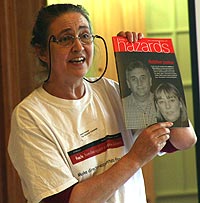Workplace Deaths Fall But HSE Statistics Do Not Show Full Picture
The number of people killed at work in Britain fell to a record low of 151 in 2009/2010 – down from 178 the previous year, and 31 per cent lower than the average figure for the last five years.
However, Greater Manchester Hazards have pointed out repeatedly that the official HSE figures do not reflect a true picture of workplace injury and deaths. Referring particularly to the figures just in the North West, Hilda Palmer Co-ordinator of GMHC said:
 “No-one should die because they went to work to earn a living, except in rare, freak and unavoidable accidents. But yet again we must point out that the HSE figures – 19 compared to an average of 27 in the past 5 years and 23 in 2008/09 - are NOT the total national figures for those killed by work and should not be reported as such. The UK Statistics Authority in its assessment of the HSE’s compliance with the code of practice for official statistics, May 2010, states that the ‘HSE does not produce an overall figure for work-related fatalities in Great Britain.’ and makes recommendations that they ‘investigate the feasibility of producing statistics on the total number of work-related injuries and fatalities’”
“No-one should die because they went to work to earn a living, except in rare, freak and unavoidable accidents. But yet again we must point out that the HSE figures – 19 compared to an average of 27 in the past 5 years and 23 in 2008/09 - are NOT the total national figures for those killed by work and should not be reported as such. The UK Statistics Authority in its assessment of the HSE’s compliance with the code of practice for official statistics, May 2010, states that the ‘HSE does not produce an overall figure for work-related fatalities in Great Britain.’ and makes recommendations that they ‘investigate the feasibility of producing statistics on the total number of work-related injuries and fatalities’”
Hilda explained further:
“HSE reports only those killed whose deaths must be reported under RIDDOR, while we include all worker-related incident deaths and estimate this to be up to 1,500 nationally a year even in the recession. Almost all work-related deaths are not accidents, and could and should have been prevented but workers do not only die in incidents due to a lack of safety, many tens of thousands more die of illnesses such as occupational cancers, heart disease and lung diseases caused by poor working condition, up to 50,000 per year we estimate.”
In what could be seen as a message to the new government and its advisor Lord Young, who is currently carrying out a review of health and safety, HSE chair Judith Hackitt said the reduction means “continuing to strive to drive these numbers down further – not getting complacent about what we’ve collectively achieved, and recognising the new challenges as we emerge from the recession”.
The provisional figures cover the period between 1 April 2009 and 31 March 2010 and reveal that agriculture was the most dangerous industry. It recorded a massive 52-per-cent increase in fatalities, with 38 workers losing their lives on farms last year compared with the record low of 25 deaths in 2008/09.
 The National Farmers’ Union is to call for an industry coalition to address the situation. Speaking yesterday, NFU president Peter Kendall said: “The NFU notes the latest workplace fatality statistics with considerable sadness, as there is a tragic story that sits behind each one of the numbers. Any fatal accident or serious injury has a devastating impact on the families and businesses involved.
The National Farmers’ Union is to call for an industry coalition to address the situation. Speaking yesterday, NFU president Peter Kendall said: “The NFU notes the latest workplace fatality statistics with considerable sadness, as there is a tragic story that sits behind each one of the numbers. Any fatal accident or serious injury has a devastating impact on the families and businesses involved.
“In the coming months, we will establish an industry coalition with our partners and through a concerted effort will look to spread the health and safety message. We have already started to remind our members to take care but, as harvest gets underway, we will step this up and continue to support the HSE’s efforts to minimise farm deaths.”
The construction industry – traditionally on a par with agriculture as the most dangerous sector – saw a significant fall in the number of deaths on sites last year. A total of 41 fatal injuries was recorded, down from 52 deaths the previous year and way below the average for the last five years of 66. But these need to be seen in the context of a recession hitting the construction industry worst throughout 2008/2009.
 Alan Ritchie, general secretary of construction union UCATT, said: “The reduction in construction deaths is good news. Yet it must never be forgotten that each death is an individual tragedy.”
Alan Ritchie, general secretary of construction union UCATT, said: “The reduction in construction deaths is good news. Yet it must never be forgotten that each death is an individual tragedy.”
While the HSE emphasised the contribution of “good practice, leadership and employee engagement” in the record low figures it was also pragmatic about the reasons for the improved performance, acknowledging that the recession has resulted in lower levels of activity in some sectors and a decrease in the number of new, inexperienced recruits.
The Executive would not explicitly comment on any likely effect the statistics may have on Lord Young’s ongoing review but it agreed that now is not the time to ease off the throttle. A spokesperson told SHP: “Of course this is a welcome reduction in the number of work-related deaths but the evidence on economic cycles shows that while there are fewer fatalities during recessions, as we move into recovery the injury rate will rise. We cannot be complacent – we don’t want to be talking this time next year about an increase in fatalities, so we need to be extra vigilant, not less so, for when the recovery happens.”
Alan Ritchie was more forthright, saying Lord Young’s review could lead to a weakening of safety standards. He added: “Prior to the General Election the Conservatives proposed introducing private safety audits. Once a company had obtained an audit, HSE inspectors would be barred from sites unless an emergency occurred. In construction, an emergency is likely to mean a worker being killed or maimed.
The challenge for everyone concerned about safety is to ensure that the number of deaths in construction continues to be reduced as the industry recovers and activity increases. Rather than looking to reduce safety provisions the Government should be ensuring workers are safe by increasing the number of inspections and enforcement activity.”
The final and most significant words go to Hilda Palmer:
"It is vital that the ill wind of a recession, which in this case has delivered at least part of this reduction in some workplace deaths, is not overestimated or taken as justification by the Lord Young Review or the forthcoming cuts in the public sector, for an assault on health and safety laws or their enforcement.
Every worker, wherever they work, in an office, a hospital, a school, on a building site, a farm, in recycling, on an oil rig, or as an emergency worker, is at risk of injury or ill-health caused by their employer’s non-compliance. All workers are entitled to have not only their safety but their immediate and long term health protected while they are working. All workers lives are precious: a fire-fighter’s life is just as precious as a construction worker; an office worker should be protected from risks to their health and safety just like any other worker.
Over zealous health and safety, or refusing to accept risks, or too much health and safety law, did not kill these people, but non-existent compliance and weak enforcement did contribute to their avoidable deaths. This is unacceptable at any time but especially now when we are all being told we must work harder, for less money and for many years longer.”
More information on the statistics can be found on the HSE website here
See also: ‘The Whole Story’ published in Safety and Health Practitioner December 2008 here
Footnote: Hilda Palmer from GM Hazards Campaign is a guest speaker at the forthcoming IER conference, Health and Safety: A New Agenda At Work? in Liverpool 13th July.
Source: GMHC / HSE / SHP


 “No-one should die because they went to work to earn a living, except in rare, freak and unavoidable accidents. But yet again we must point out that the HSE figures – 19 compared to an average of 27 in the past 5 years and 23 in 2008/09 - are NOT the total national figures for those killed by work and should not be reported as such. The UK Statistics Authority in its assessment of the HSE’s compliance with the code of practice for official statistics, May 2010, states that the ‘HSE does not produce an overall figure for work-related fatalities in Great Britain.’ and makes recommendations that they ‘investigate the feasibility of producing statistics on the total number of work-related injuries and fatalities’”
“No-one should die because they went to work to earn a living, except in rare, freak and unavoidable accidents. But yet again we must point out that the HSE figures – 19 compared to an average of 27 in the past 5 years and 23 in 2008/09 - are NOT the total national figures for those killed by work and should not be reported as such. The UK Statistics Authority in its assessment of the HSE’s compliance with the code of practice for official statistics, May 2010, states that the ‘HSE does not produce an overall figure for work-related fatalities in Great Britain.’ and makes recommendations that they ‘investigate the feasibility of producing statistics on the total number of work-related injuries and fatalities’”  The National Farmers’ Union is to call for an industry coalition to address the situation. Speaking yesterday, NFU president Peter Kendall said: “The NFU notes the latest workplace fatality statistics with considerable sadness, as there is a tragic story that sits behind each one of the numbers. Any fatal accident or serious injury has a devastating impact on the families and businesses involved.
The National Farmers’ Union is to call for an industry coalition to address the situation. Speaking yesterday, NFU president Peter Kendall said: “The NFU notes the latest workplace fatality statistics with considerable sadness, as there is a tragic story that sits behind each one of the numbers. Any fatal accident or serious injury has a devastating impact on the families and businesses involved. Alan Ritchie, general secretary of construction union UCATT, said: “The reduction in construction deaths is good news. Yet it must never be forgotten that each death is an individual tragedy.”
Alan Ritchie, general secretary of construction union UCATT, said: “The reduction in construction deaths is good news. Yet it must never be forgotten that each death is an individual tragedy.”